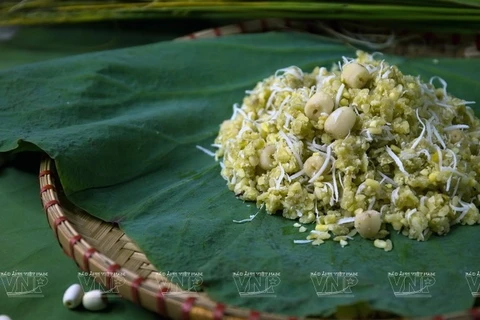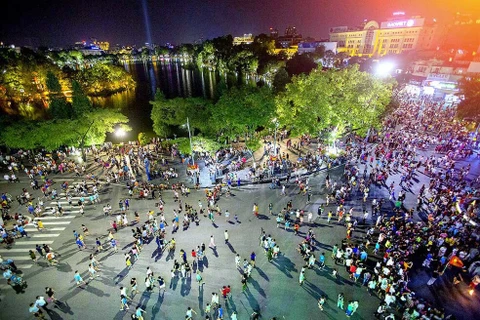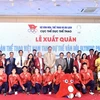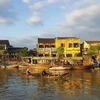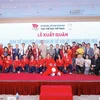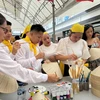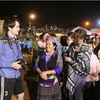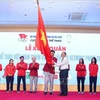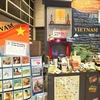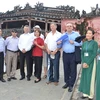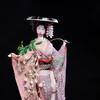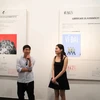Hanoi (VNA) – Hanoi is making the best use of its cultural and human resources to create internal strength and an important driving force to act for its sustainable development.
The capital city is aiming to join cities around the world with a branded and competitive cultural industry, with the establishment of new and iconic cultural works of regional and global stature.
Cultural products bearing Hanoi brand
Composer Quoc Trung is known for major music shows, notably the Monsoon International Music Festival held in Hanoi. Passionate for music, Trung used to be concerned about building a cultural and music brand on a global scale for Hanoi. He has been fortunate to take part in music festivals in different countries and cities. In the small town of Rosilde in Denmark with a population of only a few tens of thousands, the world’s biggest music festival is held annually, attracting over 150,000 visitors from Scandinavia and Europe with seven stages and 170 bands over the course of a week.
Trung wondered why Hanoi does not hold a similar festival on a similar scale with the participation of artists from at home and abroad over multiple days. It should also leave a special and unique impression of the beauty and atmosphere of Hanoi. A major music festival should be held regularly to build a reputation on the international arena, bring pride to local residents and introduce new faces to audiences.
As a person dedicated to art, People’s Artist Trung Hieu said in order to develop Hanoi’s performing arts, it must first achieve professionalism in terms of infrastructure and personnel. The combination between art and modern sci-tech will bring unforgettable experiences to audiences and attract more and more fans to the event.
Moreover, localities should issue suitable mechanisms to make it easier for media agencies to organise shows, he said.
Forming cultural spaces
Hanoi regards culture as an important “soft resource” in the current trend, so Hanoi is focusing on developing several sectors with existing advantages and potentials such as cultural tourism, handicrafts, performing arts, movies, design and cuisine. The city is also focusing on creating cultural spaces to meet public demand for entertainment while facilitating creative activities.
A number of cultural spaces have opened recently and have already earned a place in public minds, notably those in downtown Hoan Kiem district that have attracted numerous visitors, including the walking areas around the Old Quarter and Hoan Kiem Lake, a reading culture space, and Phung Hung mural space.
A leader of Hoan Kiem district said walking streets have given a boost to trade and tourism, thus increasing people’s incomes and revenue for the State budget.
In early 2022, residents of the Bat Trang pottery making village were delighted to debut a centre introducing the quintessence of Vietnamese craft villages nationwide.
Chairwoman of the Hanoi Association of Handicrafts, Fine Arts and Craft Villages Ha Thi Vinh said the centre houses a Bat Trang pottery museum that tells the story of the village’s ancestors nearly 1,000 years ago when about 23 families left their homeland in Bo Bat, Yen Mo district, the northern province of Ninh Binh, together with King Ly Cong Uan on a boat to establish the village we see today.
The centre is a place to experience craft making, promote trade among craft villages, introduce contemporary arts, and auction artistic works, she said.
Hanoi is encouraging the building of cultural spaces to serve the spiritual lives of residents and develop unique and creative cultural products. It will issue policies to turn creative spaces into innovative eco-systems, and sustainably develop start-ups and innovation, as well as the night-time and urban economies./.
The capital city is aiming to join cities around the world with a branded and competitive cultural industry, with the establishment of new and iconic cultural works of regional and global stature.
Cultural products bearing Hanoi brand
Composer Quoc Trung is known for major music shows, notably the Monsoon International Music Festival held in Hanoi. Passionate for music, Trung used to be concerned about building a cultural and music brand on a global scale for Hanoi. He has been fortunate to take part in music festivals in different countries and cities. In the small town of Rosilde in Denmark with a population of only a few tens of thousands, the world’s biggest music festival is held annually, attracting over 150,000 visitors from Scandinavia and Europe with seven stages and 170 bands over the course of a week.
Trung wondered why Hanoi does not hold a similar festival on a similar scale with the participation of artists from at home and abroad over multiple days. It should also leave a special and unique impression of the beauty and atmosphere of Hanoi. A major music festival should be held regularly to build a reputation on the international arena, bring pride to local residents and introduce new faces to audiences.
As a person dedicated to art, People’s Artist Trung Hieu said in order to develop Hanoi’s performing arts, it must first achieve professionalism in terms of infrastructure and personnel. The combination between art and modern sci-tech will bring unforgettable experiences to audiences and attract more and more fans to the event.
Moreover, localities should issue suitable mechanisms to make it easier for media agencies to organise shows, he said.
Forming cultural spaces
Hanoi regards culture as an important “soft resource” in the current trend, so Hanoi is focusing on developing several sectors with existing advantages and potentials such as cultural tourism, handicrafts, performing arts, movies, design and cuisine. The city is also focusing on creating cultural spaces to meet public demand for entertainment while facilitating creative activities.
A number of cultural spaces have opened recently and have already earned a place in public minds, notably those in downtown Hoan Kiem district that have attracted numerous visitors, including the walking areas around the Old Quarter and Hoan Kiem Lake, a reading culture space, and Phung Hung mural space.
A leader of Hoan Kiem district said walking streets have given a boost to trade and tourism, thus increasing people’s incomes and revenue for the State budget.
In early 2022, residents of the Bat Trang pottery making village were delighted to debut a centre introducing the quintessence of Vietnamese craft villages nationwide.
Chairwoman of the Hanoi Association of Handicrafts, Fine Arts and Craft Villages Ha Thi Vinh said the centre houses a Bat Trang pottery museum that tells the story of the village’s ancestors nearly 1,000 years ago when about 23 families left their homeland in Bo Bat, Yen Mo district, the northern province of Ninh Binh, together with King Ly Cong Uan on a boat to establish the village we see today.
The centre is a place to experience craft making, promote trade among craft villages, introduce contemporary arts, and auction artistic works, she said.
Hanoi is encouraging the building of cultural spaces to serve the spiritual lives of residents and develop unique and creative cultural products. It will issue policies to turn creative spaces into innovative eco-systems, and sustainably develop start-ups and innovation, as well as the night-time and urban economies./.
VNA

